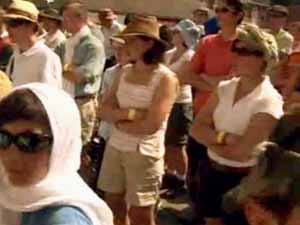Recently, I wrote an article about what I believe is the proper Catholic attire for the Chartres Pilgrimage, and I asked TIA to post it on its website. I am convinced that it is my obligation as a priest to warn Catholics when I see them going astray in customs. That was the intention of my article: to point out wrongdoings so that the situation might improve in the future.
Not to my surprise, the article caused a big reaction. Many people wrote or called me, expressing pros and cons, and I was told that some conservative Internet forums reached record numbers of discussions, using my piece as a reference point. Probably Mr. Michael Matt, editor of The Remnant and in charge of the American delegation to the Chartres Pilgrimage, also received many pro and con reactions, since I named him in my article.
Perhaps pressured by those reactions, Mr. Matt felt obliged to write an Editor’s Note in the August 15 issue of The Remnant. In it he defends the pilgrimage as it is and attacks my critique. I am asking TIA to post his editorial also when this answer is placed on its website so that in case there is any question about what he said, my readers can check it out.
An injurious omission and insinuation


Instead of correcting obvious defects, the American leadership of Chartres Pilgrimage struggles to keep it 'as is' |
Mr. Matt is a traditionalist leader and as such, he should know how to address a priest in a response. I was sadly shocked by the fact that, although he was obviously responding to my article on the Chartres Pilgrimage, Mr. Matt skipped my name and attributed my piece to "some folks” at a “certain website,” and referred to the author as “they” throughout his piece.
Doing so, he indirectly told his audience that I am not to be taken seriously and that my name is not even worthy of mention, insinuating that my article would have been written by others – the TIA staff.
I have to say that, even though I do not hold any personal resentment, by his omission and insinuation Mr. Matt was rudely disrespectful toward the priestly dignity with which I am invested. He should have acknowledged that the piece was written by me, or at least should have made semblance that he believed that the piece was mine since I signed it. This is the minimum one would expect from a person who would hold the banner of a remnant that continues to be faithful to Catholic traditions.
For his knowledge and for that of his audience, I inform them here that I actually wrote that article, with some very minor editing by the TIA desk. Any responses were based upon reactions to what I wrote.
A weak approach that lacks vigilance
Looking at Mr. Matt’s supposed refutation of my critique of the Chartres Pilgrimage, one sees that his approach is “positive.” That is, he implies that I am unjust because I do not point out the good fruits of those pilgrimages, which he goes on to list.
The least I can say is that this approach lacks vigilance. A good physician is concerned about the parts of the body that are sick, not the parts that are healthy. This is the same position that should be taken by a good priest regarding the souls of his flock or a good Catholic leader regarding those under his direction or influence.
Therefore, Mr. Matt, as the leader of the American delegation to the Chartres Pilgrimage, should have been the first person to notice and point out the revolutionary tendencies present in it. He did not do this, and when he was warned about them, he simply rebuked the criticism, because the positive aspects were not taken into consideration.
What kind of leader does Mr. Matt look like with this approach? If he is going to continue to ignore just criticisms of the pilgrimage, then maybe there is someone else out there better fit and willing to lead future pilgrimages.
Empty responses trying to defend the status quo
Reading his response, I found it difficult to believe that a man of Mr. Matt’s intelligence - with his track record of hard-hitting responses in the traditional sphere, both liturgically and culturally - honestly thinks that he was refuting my position. His editorial is an ensemble of empty responses whose only goal is to justify the status quo of the Chartres Pilgrimage. I will list his answers/accusations:
1. First, in the beginning, he says that I should not criticize the Chartres Pilgrimages because I have not participated in any of them.
This is an empty argument. I no more needed to be at Chartres to criticize the bad customs that I saw than I need to be married in order to counsel married couples. In this case, as the saying goes, a picture is worth a thousand words. I could easily see from the photo of the American pilgrims published in The Remnant as well as from the video production by PBS on the last Chartres Pilgrimage that many of the pilgrims were following today’s revolutionary customs.

Young women in shorts and pants laying down close to young men do not fit with Catholic standards, above and below

The generalized use of shorts, below, makes the Chartres Pilgrimage not much different than a World Youth Day
 |
2. Second, Mr. Matt asserts that I should not judge the people who appeared in those pictures because many of them are not traditionalists, but were simply invited by traditionalists.
Even if many pilgrims may not have been traditionalists, this does not answer the fact that indeed there were many who believe themselves to be traditional who definitely did not meet the standards of Catholic decorum and modesty. Those standards can be defined as how any Catholic would have been expected to dress prior to the revolution in the Church. Anyone not willing to accept this as a basic criterion is not a traditionalist.
Case in point, women wearing pants or shorts is no more a development of tradition in customs than the Novus Ordo Missae is a continuation of tradition in Liturgy. Both represent a radical break with the past.
3. The third argument was completely beside the point. The “scouting groups” and the “jeanettes” who were wearing uniforms and marched in good order were used by Mr. Matt as if to prove that the customs at the Pilgrimage are good. What did this have to do with my criticism?
This is perhaps the most glaring weakness in Mr. Matt’s response in highlighting what he believes to be the praiseworthy fruits of the Chartres Pilgrimage. It does not follow good logic. I never criticized the good discipline and presentation of the boy scouts and “jeanettes.” In my opinion, their presence only proves that it is possible to dress well and take part in the long walk. If they could do it, why cannot the other participants – and especially the traditionalists - follow suit? If they are required to wear their traditional uniforms, why cannot others also adopt a dignified dress code?
Mr. Matt also mentions the priests in cassocks as good examples on the pilgrimage. I would agree, and again would say that his argument does not counter my critique, but only reinforces it. If priests can wear cassocks in 80+ degree heat, then why cannot a man wear at least a collared shirt and light sport coat, in keeping with the standards of a Catholic gentleman, always accepted and expected until the 1960s?
4. Fourth, Mr. Matt insinuates that I am not a charitable priest concerned about souls when he affirms that a good priest would never turn away anyone who was not properly dressed on the pilgrimage.
I believe he is assuming too much. I did not address this issue in my article.
I think that the question of dressing and behaving properly should be dealt with by the leadership of that pilgrimage before it begins. Meetings should be held to establish a dress code, what the pilgrims should bring, and how they should make a dignified presentation of the group as a whole. I wrote my critique with the intention of helping for the future. What Mr. Matt does is to avoid any valid criticisms of his group by justifying it as it is now.
5. Fifth, Mr. Matt tries to ridicule some points of my article such as my suggestion for participants to wear jackets and sit on folding chairs. When I suggested these as examples of how one can maintain his/her proper dignity during pilgrimages, I was inspired by Portuguese pilgrims to Fatima before the Council – the men wore jackets and the women dresses - and also by soldiers who wore dignified uniforms during long marches.

Lightweight camping benches are widely available at reasonable prices (above, from $10 to $40) |
Regarding my suggestion that pilgrims carry folding chairs to use during the Masses and to avoid sitting on the ground, there are small folding canvas benches that probably weigh less than a pound and are very easy to carry in back-bags. It would be a small sacrifice to make in order to maintain one’s dignity. Also, the number of pilgrims has no bearing on the point. Whether there are 150,000, 15,000, or just 15, each would carry just one folding chair.
The same sarcastic tone was taken with regard to my comment that pilgrims should not wear tennis shoes. Before the ‘60s, no one wore tennis shoes except for sports. Then, in the name of comfort, everyone started wearing them everywhere – even to church. Today there are many decent walking shoes available that are not uncomfortable or dressy.
Finally regarding jackets, I stress what I have already said: if many priests could wear their cassocks all the time in the pilgrimage to keep their priestly dignity, then why cannot a man wear at least a collared shirt and light sport coat - and yes, with a tie - in keeping with the image of a Catholic gentleman?
With the intention of helping, I suggested those customs be adopted that were always used when men still cared about their dignity. I do not understand why Mr. Matt and the traditionalist Catholics under his command are so opposed to practices that everyone followed until about 50 years ago. I cannot find any other answer except that they are adapting to the Cultural Revolution.
If this is true, as I believe it is, Mr. Matt’s ridicule of my suggestions would seem to be just a ploy to justify these new bad customs. Again, it is not what one would expect of a traditionalist leader.
The whole “refutation” of Mr. Matt to my article obviously was an effort to present the pilgrimage as “positive” and “good enough” to justify the adoption of those mentioned revolutionary customs.
When it comes to serving God and Our Lady, however, the “positive things” and the “good enough” are not sufficient. We should be as good as God has always expected Catholics to be, no matter the age or time. The moral proverb teaches us, bonum ex integra causa, malum ex quocumque defectu. Loosely translated, it means: an action is good when it is good in every respect; when there is any defect it is bad.
In a warning to the Church of Ephesus in Chapter 2 of the Apocalypse, Our Lord threatened to remove its candlestick - that is, its vocation - because its members lost their first love, in spite of praising them for their defense of the Catholic Faith. The Ephesians, in response, did not try to use the good to ignore the bad. In fact, once they were aware of their moral lapse, they repented, reformed their lives and returned to their former fervor. They did not receive the grace of God in vain.
Will Mr. Matt and those of like mind go and do likewise? That is my hope and prayer.
Posted September 10, 2009

At the request of Fr. Paul Sretenovic, we reproduce below the comments
of Mr. Michael Matt published in The Remnant, August 15, 2009 - TIA
Editor's Note
It has come to our attention that a certain website recently posted criticisms of the Chartres Pilgrimage based on a few pictures of inappropriately-attired pilgrims in the PBS documentary that aired in 250 cities this past June. The criticisms were evidently penned by a couple of folks who've never actually been to Chartres. So, briefly, I would like to offer some perspective.
First of all, I would agree that there is always room for improvement where sloppy dress and modesty are concerned, and the Pilgrimage is no exception. However, one of the most striking dimensions of the Pilgrimage to Chartres is the discipline, devotion, good behavior and modest dress of the vast majority of over ten thousand young French Catholics. It is something that must be experienced to be fully appreciated and certainly no 9-minute documentary produced by a secular organization can do it justice.
Secondly, not all the pilgrims seen in the PBS documentary are traditional Catholics. Many are brought to the Chartres Pilgrimage ostensibly "on holiday" by Traditionalist scouting groups, chapels and organizations in a concerted effort to expose as many young people as possible to the Traditional Mass and way of life.

Inappropriate dress and customs at the Mass

Photos from the PBS Chartres video |
Thirdly, thousands of the boys and young men on this Pilgrimage (as well as the Chartres-to-Paris pilgrimage operated by the Society of St. Pius X on the same weekend), are traditional Catholic scouts who are required to wear the traditional scouting uniform that’s been in use in Europe for over 100 years. Anyone claiming to be offended by the rugged uniform of the scouts must be joking.
Fourthly, the heart of the Pilgrimage is that small army of "jeanettes" from Riaumont, whose brilliant spirit and famous uniforms – blue blouse, yellow scarf, blue skirt and traditional beret – have long since earned them the status of official pilgrim models of Chartres. At any given moment, one can see dozens of the "little troops from Riaumont trudging "manfully" along singing their lungs out and praying like saints. There are several very touching images of them, in fact, on the PR documentary.
And lastly, there are scores of priests and seminarians leading the charge in this regard, walking in 80-degree heat in black cassocks and surplices for three day beneath the blazing sun, delivering countless meditations on spirituality, moral theology, self-sacrifice, counterculturalism and the process of turning away from the world and its allurements in order to give our lives to the pursuit of holiness. These priests wouldn’t think of turning a pilgrim away even if he were sloppily dressed … perhaps especially if he were! The whole point of the Pilgrimage, after all, is conversion.
Young people from all over Europe come to the Pilgrimage and are exposed to Tradition, the Latin Mass, Traditionalist priests and the heart and soul of the Pilgrimage to Chartres – scores of rock-solid Traditional Catholic young people who dress and behave as models of Catholic living.
The number of converts and reverts resulting from this Pilgrimage, then, is astronomical; as is the number of vocations to the priesthood and religious life. From The Remnant Chapter alone over the past eighteen years; 14 young men have become priests and 8 Catholic couples met on the Pilgrimage and are now married and raising traditional Catholic families. No single event taking place anywhere else in the world can compare to the Pilgrimage in terms of its incredible success rate where the conversion of young people is concerned.
Incredibly, our Internet critics also complained that men on the Pilgrimage were not wearing collared shirts, more formal pants and a sports jacket. They complained exhausted and "sloppy looking” pilgrims were seen sitting on the ground during their breaks rather than in chairs. If this were truly a Catholic Pilgrimage, they argued, the pilgrims would have simply packed 15,000 folding chairs on their backs as they set out for the grueling 3-day, 2-night, 70-mile event.
I will not address these last grievances until I've been adequately assured that someone’s not pulling our leg. For surely that must be the case. In the meantime, here are more reactions to the Chartres Pilgrimage from those who actually know something about it – the ones who were there.

|